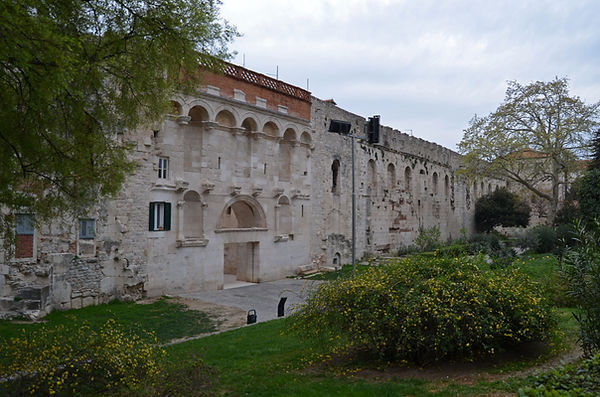Split (Roman Spalatum) is city on the Dalmatian coast on a promontory in Kaštelanski Bay, southeast of Salona (modern Solin, Croatia). The etymology suggested by Constantine VII Porphyrogennetos from palatium (palace) is now considered incorrect—possibly, the Greek name was derived from a plant used in the manufacture of perfumes. Sometime before 305, Diocletian built a residence on this obscure site for his years of retirement; it was constructed of local limestone and brick, while marble, mosaic decoration, and statues of sphinxes were imported. Diocletian's villa was square in plan, had four gates, and was surrounded by limestone walls with square and octagonal towers. Two principal streets (in some places colonnaded) divided the villa complex into four quarters. The villa contained the Mausoleum of Diocletian, a temple, baths, private apartments, and an aqueduct. After Diocletian's death Spalatum experienced a period of stagnation; according to the 5th-century Notitia Dignitatum, it housed a military clothing factory. Excavations have uncovered only modest traces of building activity in the 5th-6th century; baths were adapted for use as churches, and twin basilicas were erected outside the walls. In the 7th century the inhabitants began to rebuild Spalatum as a small town: some columns and floor slabs were removed to obtain materials for renovation; the standard of living declined. Then new forms (in construction technique and pottery), reflecting Slav influence, emerged. Thomas the Archdeaconrelates that the inhabitants of Salona, after the destruction of their city in the 630s, fled to Split. The episcopal center was transferred there, and Diocletian's mausoleum was transformed into the cathedral. Small as it was, Split played an important role in the making of the Croatian state in the loth-11th century and as the site of local synods. The archbishop of Split tried to maintain ties with both Rome and Constantinople. The Byzantines claimed certain administrative rights over this area. From the 12th century onward Split was several times sacked by the Hungarians and Venetians. In 1420 it finally recognized Venetian supremacy.
Page under construction








